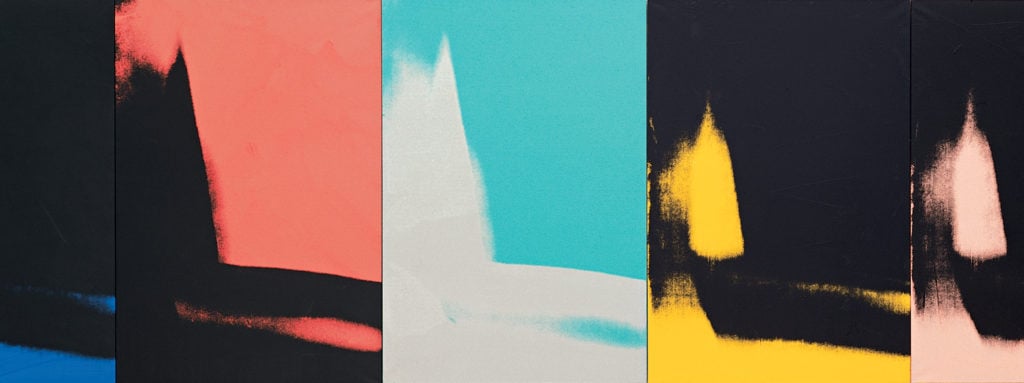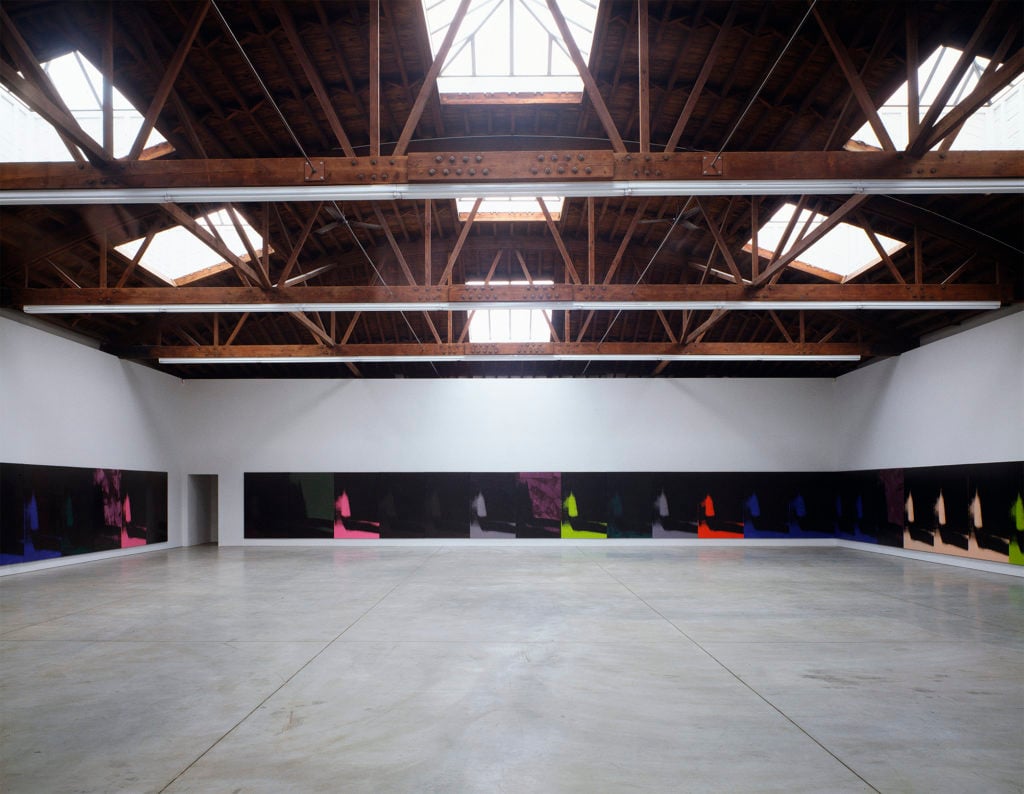Art & Exhibitions
Andy Warhol’s Epic ‘Shadows’ Will Be Shown in New York City for the First Time in 20 Years
The Dia Art Foundation will present the work in conjunction with the Pop artist's Whitney retrospective.

The Dia Art Foundation will present the work in conjunction with the Pop artist's Whitney retrospective.

Sarah Cascone

New Yorkers are getting a double dose of Andy Warhol this fall.
In addition to the Pop art icon’s highly anticipated retrospective at New York’s Whitney Museum of American Art, the Dia Art Foundation is planning an ambitious reunion of Warhol’s monumental Shadows. Dozens of the series’ brightly colored canvases, which the artist designed to be installed edge to edge, will take over the Calvin Klein headquarters in Manhattan this October. (The complete set, comprising 102 canvases, is rarely shown at one time, but 50 or so silkscreens are expected to be on view in this iteration.)
Like the artist’s famed Marilyn or Mao silkscreens, Shadows is an exercise in obsessive repetition: Two photographs of shadowy forms are printed over and over again in vibrant shades of aqua, violet, coral, and yellow. This viewing experience is unique—most of Warhol’s other series have been split up and sold to lots of individual buyers, making it nearly impossible to reunite them.
“We all think of Warhol as the artist who worked with serial images, and we see these iconic images reproduced so frequently, but you rarely see the way he first presented this work,” Dia’s director Jessica Morgan told artnet News. “It’s this idea of this endless variety within similitude.”
Every time Dia shows the Shadows, curators arrange the canvases in the same order in which they were originally hung by Warhol’s assistants Ronnie Cutrone and Stephen Mueller. (The number of silkscreens ranges based on the size of the room.) And although each individual canvas might at first glance appear identical, experiencing the entire series at once allows the viewer to appreciate the subtle differences inherent in the silkscreening process.

Andy Warhol, Shadows (1978–79). Installation at Dia Center for the Arts. Photo by Cathy Carver courtesy of Dia Art Foundation.
“Not only are there these various colors, the canvas has a very gestural quality,” Morgan said. Seeing the entirety of the Shadows, perhaps Warhol’s most abstract work, “will offer a different perspective on an artist who we think we know.”
The exhibition is taking place at the urging of Donna De Salvo, curator of “Andy Warhol—From A to B and Back Again” at the Whitney. Now the museum’s deputy director for international initiatives, De Salvo credits her time at Dia, where she was a curator from 1981 to 1986 and where she first met Warhol, for immersing her in the Pop art great’s work.
“Dia’s decision to present Shadows concurrently with the retrospective at the Whitney adds crucially to our effort to provide a holistic view of Warhol’s oeuvre and offers the public an unprecedented opportunity to map Warhol’s trajectory and to experience the significance of seriality in his work,” De Salvo said in a statement. “Shadows is a Warholian tour de force, an unexpected culmination of many of the experiments that Warhol pursued throughout his career, from his first explorations of photography in the 1950s, to his engagement with light, shadow, and abstraction in the 1970s.”
To create the Shadows, Warhol photographed two maquettes, a taller “peak” and a shorter “cap” in dramatic lighting, printing the latter in negative. It’s a reference to Plato’s Allegory of the Cave, said Morgan, noting that “Warhol is playing with classical mythology while producing a pop icon.”
Dia’s co-founder Heiner Friedrich commissioned Shadows in 1978. It was last shown in New York City, at Dia’s former Chelsea headquarters, in 1998–99, before it inaugurated the organization’s flagship in Beacon, New York, in 2003. (It is currently the only piece by Warhol in Dia’s collection; the foundation donated the rest of its holdings of the artist’s work to Pittsburgh’s Andy Warhol Museum.)
After a decade on view at Dia:Beacon, Shadows went on a world tour, hitting up institutions with architecturally appropriate spaces, like the circular Hirshhorn Museum and Sculpture Garden in Washington, DC.
When De Salvo first approached Dia about bringing the work back to New York during the retrospective, the only roadblock was finding a place to show it. Dia already had exhibitions planned at its spaces in the city. But the foundation was already working with Calvin Klein on other projects, and Morgan realized that the ground floor space at the company’s headquarters, sometimes used for events, fit the Dia aesthetic perfectly. “It’s an industrial building without too much distracting detail,” she said.
In the lead-up to the exhibition, Calvin Klein is helping support conservation of the Shadows. (The silkscreens are in good condition, but any project involving 102 individual canvases is a big undertaking.) “When you install the piece, the canvases literally align, so historically there’s been a lot of handling involved to get the hang in a perfect configuration,” Morgan explained. The conservators are replacing the backing on the canvases and adding cleats that will allow Shadows to be hung without having to adjust each canvas individually.
Following the New York exhibition, Shadows will return to Dia:Beacon, where it will be on longterm view. “As much as it was fun to see it everywhere else,” Morgan said, “We’re glad to have it back now.”
“Andy Warhol: Shadows” will be on view at the Calvin Klein headquarters, 205 West 39th Street, New York, October 26–December 15, 2018. Programming for the Shadows will include a talk by Whitney Museum of American Art senior curator Donna De Salvo and a panel discussion led by Dia Art Foundation director Jessica Morgan.
“Andy Warhol—From A to B and Back Again” is on view at the Whitney Museum of American Art, 99 Gansevoort Street, New York, November 12, 2018–March 31, 2019. It will then travel to the San Francisco Museum of Modern Art in spring 2019 and the Art Institute of Chicago in fall 2019.